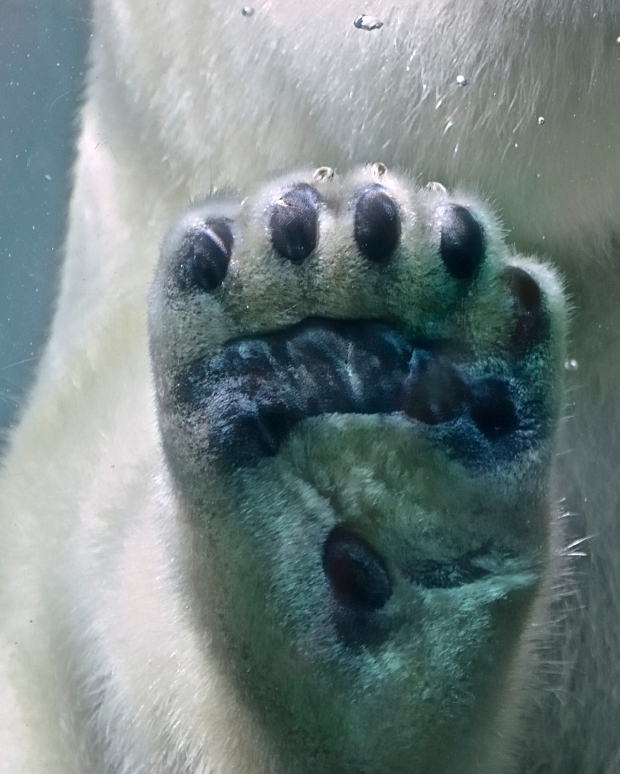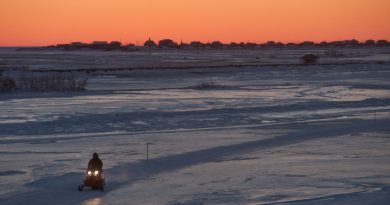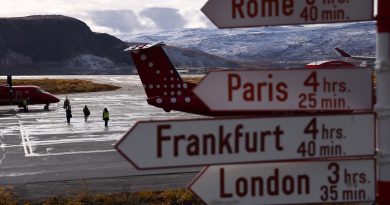Small grizzlies dominate bigger polar bears: study

North Slope grizzly bears may be little, but when it comes to grabbing morsels of bowhead whale scraps, they are mighty — as the region’s polar bears have learned the hard way.
A newly published study by U.S. Fish and Wildlife Service scientists found that the smaller grizzly bears dominate the larger polar bears during foraging sessions at the bone pile left on the beach by Inupiat whalers from Kaktovik.
Lead author Susanne Miller, a Fish and Wildlife Service biologist who specializes in polar bears, said the finding surprised scientists, who made the discovery almost by accident.
Several years ago, with scarcer summer and fall sea ice driving more polar bears ashore, she and her colleagues set out to observe the bears to see if they could spot any behavioral changes. But the grizzlies interrupted their work.
“Brown bears just showed up and polar bears left,” she said. So instead the researchers decided to focus on the interspecies behavior.
The new study, published in the Journal of Mammalogy, is based on detailed observations recorded from 2005 to 2007 by biologists stationed in shifts at the bone pile. From the safety of their vehicles, the biologists would work three-hour shifts from dusk to dawn — the time when human-avoiding North Slope grizzlies show up at the bone pile — and make detailed notes of all the interactions they saw and recorded with the help of a spotlight. (Some of the recordings the team made are shared in the video below.)
Submissive behavior
In most of the 137 encounters they observed between the two bear species, polar bears reacted submissively, even though the grizzlies did not exhibit overtly aggressive behavior. In fact, though they are far fewer and smaller, the grizzly bears completely displaced the polar bears from the bone pile in about half the encounters. Though polar bears sometimes acted aggressively among themselves, they mostly tolerated each other. But they almost always tried to avoid the grizzlies.
The surprising finding comes amid uncertainty about polar bears’ future, as they are increasingly driven from their shrinking sea ice habitatand into areas with fewer food resources.
Though the formal study is over, biologists said they continue to see the same pattern of polar-grizzly interactions. The grizzlies still rule, even though they “look like they’re half the size of the polar bears,” Miller said.
In September, study coauthor Ryan Wilson was watching about 15 polar bears eating from the pile when they suddenly fled. In ambled a grizzly bear.
“He just wandered in from behind the bone pile and all but one of the big polar bears ran away,” Wilson said.
“You can be watching the polar bears at the bone pile and all of a sudden they’ll split. And you kind of know from past experience that there’s probably a grizzly bear walking up the beach,” said Richard Shideler, a Fairbanks-based biologist for the Alaska Department of Fish and Game who contributed to the study.
In recent years, as summer and fall sea ice has dwindled, more Southern Beaufort Sea polar bears are spending time on land, especially in Kaktovik, where bowhead scraps have become important to their diet. “There’s a reliable, predictable food resource that’s going to be there every year,” Wilson said.
In 2012, the year of the record-low ice minimum, 80 polar bears were spotted lurking around the Kakotvik bone pile.
What’s causing polar bears to flee?
For North Slope grizzlies — the smallest of Alaska’s brown bears — the bone pile is also an enticing food source. For most of the year, they depend on plants and a smattering of mostly lean prey animals, so fatty whale meat is a welcome change, Miller said.
But there is no evidence that grizzlies are coming from elsewhere on the North Slope to feast on the Kaktovik bone pile, Shideler said.
Biologists aren’t sure what the grizzlies — some no bigger than Anchorage-area black bears — are specifically doing to cause polar bears to flee. There is possibly a “stare-down,” and scent likely plays a role, they said. In one instance, even the carcass of a grizzly bear that was dumped by villagers at the bone pile was enough to spook the polar bears, Miller said.
Shideler, who has spent several years studying North Slope grizzlies, said the answer may lie in those bears’ “aggressive nature.”
“I think it’s attitude,” he said. “They’re more aggressive in terms of bear-bear interaction.”
They don’t snarl in the way that wolves and dogs do, but they show their aggression in their stances, their ear positions and “just the way they walk,” he said.
Grizzly behavior
North Slope grizzlies are sparsely distributed and may have honed aggressive behavior out of necessity in a habitat where food is scarce, the study suggests. Polar bears, in contrast, evolved to thrive in a marine environment, swimming away from land-based animals that might be competitors for food.
And North Slope grizzlies may have a more pressing need for meat at that time of year, as they are fattening up for hibernation, the study says. Meanwhile, polar bears, which do not hibernate, are conserving energy as they wait for sea ice to return and may be able to afford to cede first dibs at the bone pile to the grizzlies. It may not be worthwhile for polar bears to spend the energy competing with grizzlies, especially at that time of the year.
Miller and Wilson said they still travel to the Kakotvik each fall and hope to continue studying grizzly-polar bear interactions.
Related stories from around the North:
Canada: Study shows polar bears relocating to icier Canadian Archipelago, Alaska Dispatch News
Finland: Finland’s bears are on the move, Yle News
Russia: Russian oil company studies polar bears, Barents Observer
Sweden: Petition to restrict brown bears in North Sweden, Radio Sweden
United States: Scientists seek cause of patchy baldness in some Beaufort Sea polar bears, Alaska Dispatch



